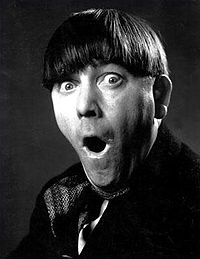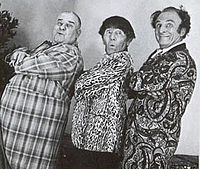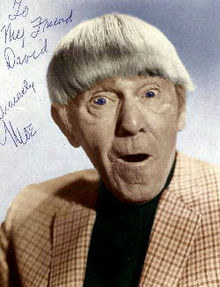- Moe Howard
-
Moe Howard 
Howard in 1933Born Moses Harry Horwitz
June 19, 1897
Bensonhurst, Brooklyn,
New York, United StatesDied May 4, 1975 (aged 77)
Los Angeles, California,
United StatesCause of death Lung cancer Occupation Actor
ComedianYears active 1909–1975 Spouse Helen Schonberger (m. 1925–1975) Website threestooges.net Moses Harry Horwitz (June 19, 1897 – May 4, 1975), known professionally as Moe Howard, was an American actor and comedian best known as the leader of The Three Stooges, the farce comedy team who starred in motion pictures and television for four decades. His distinctive hairstyle came about when he was a boy and cut off his curls with a pair of scissors, producing a ragged shape approximating a helmet or bowl.
Contents
Early life
Moses Horwitz was born in Brooklyn, New York, neighborhood of Bensonhurst, to Solomon Horwitz and Jennie Gorovitz. He was the fourth of the five Horwitz brothers of Lithuanian Jewish ancestry. In his younger years, he got the nickname Moe and later adopted the name Harry. Although his parents were not involved in show business, Moe, his older brother Samuel and younger brother Jerome all eventually became world-famous as members of the Three Stooges.
In school, Moe initially did quite well, aided by a prodigious memory. In later years, this helped him in his acting career, making memorizing his lines quick and easy. Moe loved reading, as his older brother Jack commented: "I had many Horatio Alger books and it was Moe's greatest pleasure to read them. They started his imaginative mind working and gave him ideas by the dozen. I think they were instrumental in putting thoughts into his head to become a person of good character and to become successful."[1]Although his "bowl cut" hairstyle is now widely recognized, when he was a child his mother refused to cut his hair, letting it grow to shoulder length. One day, he could not take his classmates' years of teasing any longer, sneaked off to a shed in his parents' back yard, and with the help of a friend and a mixing bowl, cut his hair. Moe was so afraid his mother would be upset (she enjoyed curling his hair) that he hid under the house for several hours, causing a panic. He finally came out and his mother was so glad to see him that she did not even mention the hair.
Moe began to develop an interest in acting and, as a result, his schoolwork suffered. He began playing hooky from school in order to attend theater shows. Moe said, "I used to stand outside the theater knowing the truant officer was looking for me. I would stand there 'til someone came along and then ask them to buy my ticket. It was necessary for an adult to accompany a juvenile into the theater. When I succeeded I'd give him my ten cents — that's all it cost — and I'd go up to the top of the balcony where I'd put my chin on the rail and watch, spellbound, from the first act to the last. I would usually select the actor I liked the most and follow his performance throughout the play."[1]
Despite his decreasing attendance, Moe graduated from P.S. 163 in Brooklyn, but he dropped out of Erasmus Hall High School after only two months. This was the end of his formal education. To mollify his parents he took a class in electric shop, but quit after a few months to pursue a career in show business.[1]
Moe began by running errands for no fee at the Vitagraph Studios in Midwood, Brooklyn (currently the home of the CBS daytime serial As the World Turns), where he was rewarded with bit parts in movies being made there. Unfortunately, a fire at the studios in 1910 destroyed the film and most of Moe's work done there. In 1909 he met a young man named Lee Nash who would later provide a significant boost to Moe's career aspirations. In 1912, they both held a summer job working in Annette Kellerman's aquatic act as diving "girls."[1]
Career
Moe continued his attempts at gaining show business experience by singing in a bar with his older brother Shemp until their father put a stop to it, and in 1914 joining a performing troupe on a Mississippi River showboat for the next two summers. In 1921, he joined Lee Nash, who was now firmly established in show business as Ted Healy, in a vaudeville routine. In 1923, Moe spotted Shemp watching the show and yelled at him from the stage. Shemp and Moe heckled each other to a large positive response from the audience and Healy hired Shemp as a permanent part of the act. Next, Healy recruited a vaudeville violinist, Larry Fine, in 1925, to join the comedy troupe, which was billed as "Ted Healy and His Racketeers" (later changed to Ted Healy and His Stooges).[1]
By 1930, Ted Healy and his Stooges were on the verge of "the big time," and made their first movie, Soup to Nuts — featuring Ted Healy, and his four Stooges (Moe (billed as "Harry Howard"), Shemp, Larry, and one-shot Stooge Fred Sanborn) — for Fox Films (later 20th Century Fox). Shemp had never seen eye-to-eye with the hard-drinking and sometimes belligerent Healy, and left the group shortly after filming in order to pursue a solo film career. After a short search for a replacement, Moe suggested his youngest brother, Jerome ("Jerry" to his friends, "Babe" to Moe and Shemp). Healy originally passed on Jerry (whom he disliked), but Jerry was so eager to join the act that he shaved off his luxuriant auburn mustache and hair and ran on stage during Healy's routine. Healy hired Jerry, who took the stage name of "Curly."[1]
Healy and the Stooges were hired by Metro-Goldwyn-Mayer as "nut" comics, to liven up feature films and short subjects with their antics. After a number of appearances in MGM films, Healy was being groomed as a solo character comedian. With Healy pursuing his own career, his Stooges (now renamed The Three Stooges) signed with Columbia Pictures where they stayed until December 1959, making 190 short films.[1]
With Healy's departure, Moe's character assumed Healy's previous role of the aggressive, take-charge leader of the Three Stooges: a short-tempered bully, prone to slapstick violence against the other two Stooges. However, despite his rather cruel demeanor towards his pals, Moe's character was also very loyal and protective of the other Stooges, keeping them from harm and, should it befall them, doing whatever it took to save them. In many ways, Moe's on-screen persona was the antithesis of his real personality; he was quiet, loving, and generous to his family. He was also a shrewd businessman, and invested the money made from his film career wisely. However, the Stooges got no subsequent royalties from any of their many shorts: they were paid a flat amount for each one and Columbia owned the rights (and profits) thereafter.[1]
In 1934, Columbia released its first Three Stooges short, Woman Haters, where their stooge characters were not quite finalized. It was not a Stooge comedy in the classic sense, but rather a romantic farce; Columbia was then making a series of two-reel "Musical Novelties" with the dialogue spoken in rhyme, and the Stooges were recruited to support comedienne Marjorie White. Only after the Stooges became established as short-subject stars were the main titles changed to give the Stooges top billing. The version seen on TV and video today is this reissue print.[1]
Their next film, Punch Drunks, was the only short film that was written entirely by the Three Stooges, with Curly as a reluctant boxer who goes ballistic every time he hears "Pop Goes the Weasel." Their next short, Men in Black (a parody of the hospital drama Men in White) was their first and only film to be nominated for an Academy Award (with the classic catchphrase, "Calling Dr. Howard, Dr. Fine, Dr. Howard"). They continued making short films at a steady pace of eight per year, such as Three Little Pigskins (with a very young Lucille Ball), Pop Goes the Easel, Hoi Polloi (where two professors make a bet trying to turn the Three Stooges into gentlemen), and many others.[1]
 A promotional picture taken in 1975 (after Larry Fine's death), from left to right, Curly Joe DeRita, Moe Howard (who died shortly thereafter) and Emil Sitka.
A promotional picture taken in 1975 (after Larry Fine's death), from left to right, Curly Joe DeRita, Moe Howard (who died shortly thereafter) and Emil Sitka.
In the 1940s, the Three Stooges became topical, making several anti-Nazi movies including You Nazty Spy! (Moe's favorite Three Stooges film), I'll Never Heil Again, and They Stooge to Conga. Moe's impersonation of Adolf Hitler highlighted these shorts, the first of which preceded Charlie Chaplin's controversial film satire, The Great Dictator, by months.[1]
On May 6, 1946, during the filming of Half-Wits Holiday, brother Curly suffered a stroke. He was replaced in the Three Stooges by Shemp, who agreed to return to the group until Curly would be well enough to rejoin. Although Curly recovered enough to appear in Hold That Lion! in a cameo appearance (the only Three Stooges film to contain all three Howard brothers; Moe, Curly, and Shemp), he soon suffered a series of strokes which led to his death on January 18, 1952.[1]
The Three Stooges' series of shorts continued to be popular through the 1950s; Shemp co-starred in 73 comedies. (The Stooges also co-starred in a George O'Brien western, Gold Raiders, in 1951.) Moe also co-produced occasional western and musical films in the 1950s.
On November 22, 1955, Shemp died of a heart attack, necessitating the need for another Stooge. Producer Jules White used old footage of Shemp to complete four more films with Columbia regular Joe Palma filling in for Shemp (thus creating the Fake Shemp phenomenon), until Harry Cohn hired Joe Besser in 1956. According to Moe's autobiography, Howard wanted a "two stooge" act, and it was Cohn's idea, not Moe's, to replace Shemp as part of the act. Joe, Larry, and Moe filmed 16 shorts through December 1957. Shortly before the death of Columbia head Harry Cohn in February 1958, the making of short subjects came to an end. Keeping himself busy, Moe was hired by Harry Romm as an Associate Producer; stories that Howard was forced to take a job as a gofer at Columbia are completely false.[1]
Fortunately for the Stooges, Columbia sold the Three Stooges' library of short films to television under the "Screen Gems" brand. With this, the Three Stooges quickly gained a new audience of young fans. Ever the businessman, Moe Howard put together a new Stooges act, with burlesque and screen comic Joe DeRita (dubbed "Curly-Joe" because of his resemblance to Curly Howard) as the new "third Stooge." The revitalized trio starred in several feature-length movies: Have Rocket, Will Travel, Snow White and the Three Stooges, The Three Stooges Meet Hercules, The Three Stooges in Orbit, The Three Stooges Go Around the World in a Daze, and The Outlaws Is Coming.[1]
Moe, Larry and Curly-Joe continued to make live appearances, many notable "guest appearances", notably in It's a Mad, Mad, Mad, Mad World (as three firemen who appear for only a few seconds) and 4 for Texas. The boys tried their hand at a children's cartoon show titled The New Three Stooges, with the cartoons sandwiched between live action segments of the boys. But by 1965, they were close to 70 years old and couldn't handle slapstick comedy anymore. The boys were paid residually for their efforts and continued to receive the bulk of the profits from sales of Stooges merchandise.
Moe sold real estate when his show-business life slowed down, although he still did minor roles and walk-on bits in movies (Don't Worry, We'll Think of a Title, Dr. Death: Seeker of Souls) and television appearances (Here's Hollywood, Toast of the Town, Masquerade Party, Truth or Consequences and several appearances on The Mike Douglas Show). In one episode of The Mike Douglas Show, Howard, his hair in a style popular at the time, made a surprise appearance during an interview of the writer of a "where-are-they-now" book. When the audience was given the chance to ask the writer about famous people, Howard asked "What ever happened to the Three Stooges?" Finally recognized by Douglas, he then combed his hair into his trademark style. The Stooges also made several appearances on late night television, particularly The Tonight Show.
The Stooges attempted to make a final film in 1969, Kook's Tour, which was essentially a documentary of Moe, Larry and Curly-Joe, out of character, touring the country and interacting with fans. But production abruptly halted when on January 8, 1970, Larry suffered a major stroke during filming, paralyzing the left side of his body; he died on January 24, 1975 at age 72. Moe asked long-time Three Stooges supporting actor Emil Sitka to replace Larry, but this final lineup never recorded any material.
Personal life
On June 7, 1925, Moe Howard married Helen Schonberger, a cousin of magician Harry Houdini. The next year, Helen pressured Moe to leave the stage, as she was pregnant and wanted Moe nearer to home. Moe attempted to earn a living in a succession of "normal" jobs, none of which was very successful. He soon returned to working with Ted Healy.[1]
Moe and Helen had two children: Joan Howard Maurer (born 1927) and Paul Howard (born 1935).
Death
Moe was working on his autobiography, tentatively titled I Stooged to Conquer when he died of lung cancer on May 4, 1975.[1][2] He was entombed in Culver City's Hillside Memorial Park Cemetery. His wife died of a heart attack in October 1975 and was entombed next to him. Moe's autobiography was released in 1977 as Moe Howard and the Three Stooges.
Legacy
- Moe and the Three Stooges received a Star on the Hollywood Walk of Fame on August 30, 1983, at 1560 Vine Street.
- Moe was portrayed by Paul Ben-Victor in The Three Stooges, a 2000 made-for-TV biopic that focused on the trio's years in show business and their off-screen lives.
- For the 2012 Farrelly Brothers' film The Three Stooges, Moe will be portrayed by Chris Diamantopoulos.
References
External links
- My Pal Moe by Bob Bernet (featuring letters and rare photos of Moe Howard at home)
- Moe Howard at the Internet Movie Database
- Moe Howard at the Internet Broadway Database
- Moe Howard at Find a Grave
Categories:- 1897 births
- 1975 deaths
- American film actors
- American television actors
- American stage actors
- American voice actors
- People from Brooklyn
- American comedians
- American Jews
- Jewish comedians
- American people of Lithuanian-Jewish descent
- Levites
- Deaths from lung cancer
- The Three Stooges members
- Vaudeville performers
- Cancer deaths in California
Wikimedia Foundation. 2010.

